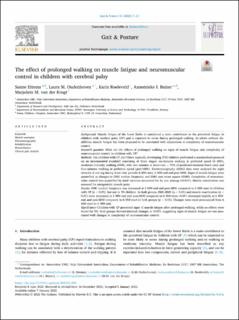| dc.contributor.author | Ettema, Sanne | |
| dc.contributor.author | Oudenhoven, Laura M. | |
| dc.contributor.author | Roeleveld, Karin | |
| dc.contributor.author | Buizer, Annemieke I. | |
| dc.contributor.author | van der Krogt, Marjolein M. | |
| dc.date.accessioned | 2023-04-18T06:52:19Z | |
| dc.date.available | 2023-04-18T06:52:19Z | |
| dc.date.created | 2022-04-11T13:30:04Z | |
| dc.date.issued | 2022 | |
| dc.identifier.citation | Gait & Posture. 2022, 93 7-13. | en_US |
| dc.identifier.issn | 0966-6362 | |
| dc.identifier.uri | https://hdl.handle.net/11250/3063452 | |
| dc.description.abstract | Background Muscle fatigue of the lower limbs is considered a main contributor to the perceived fatigue in children with cerebral palsy (CP) and is expected to occur during prolonged walking. In adults without disabilities, muscle fatigue has been proposed to be associated with adaptations in complexity of neuromuscular control. Research question What are the effects of prolonged walking on signs of muscle fatigue and complexity of neuromuscular control in children with CP? Methods Ten children with CP and fifteen typically developing (TD) children performed a standardised protocol on an instrumented treadmill consisting of three stages: six-minutes walking at preferred speed (6 MW), moderate-intensity walking (MIW, with two minutes at heart rate > 70% of predicted maximal heart rate) and four-minutes walking at preferred speed (post-MIW). Electromyography (EMG) data were analysed for eight muscles of one leg during three time periods: 6 MW-start, 6 MW-end and post-MIW. Signs of muscle fatigue were quantified as changes in EMG median frequency and EMG root mean square (RMS). Complexity of neuromuscular control was quantified by total variance accounted for by one synergy (tVAF1). Muscle coactivation was assessed for antagonistic muscle pairs. Results EMG median frequency was decreased at 6 MW-end and post-MIW compared to 6 MW-start in children with CP (p < 0.05), but not in TD children. In both groups, EMG-RMS (p < 0.01) and muscle coactivation (p < 0.01) were decreased at 6 MW-end and post-MIW compared to 6 MW-start. tVAF1 decreased slightly at 6 MW-end and post-MIW compared to 6 MW-start in both groups (p < 0.05). Changes were most pronounced from 6 MW-start to 6 MW-end. Significance Children with CP presented signs of muscle fatigue after prolonged walking, while no effects were found for TD. Both groups showed minimal changes in tVAF1, suggesting signs of muscle fatigue are not associated with changes in complexity of neuromuscular control. | en_US |
| dc.language.iso | eng | en_US |
| dc.publisher | Elsevier | en_US |
| dc.rights | Navngivelse 4.0 Internasjonal | * |
| dc.rights.uri | http://creativecommons.org/licenses/by/4.0/deed.no | * |
| dc.title | The effect of prolonged walking on muscle fatigue and neuromuscular control in children with cerebral palsy | en_US |
| dc.title.alternative | The effect of prolonged walking on muscle fatigue and neuromuscular control in children with cerebral palsy | en_US |
| dc.type | Peer reviewed | en_US |
| dc.type | Journal article | en_US |
| dc.description.version | publishedVersion | en_US |
| dc.source.pagenumber | 7-13 | en_US |
| dc.source.volume | 93 | en_US |
| dc.source.journal | Gait & Posture | en_US |
| dc.identifier.doi | 10.1016/j.gaitpost.2022.01.004 | |
| dc.identifier.cristin | 2016725 | |
| cristin.ispublished | true | |
| cristin.fulltext | postprint | |
| cristin.qualitycode | 1 | |

